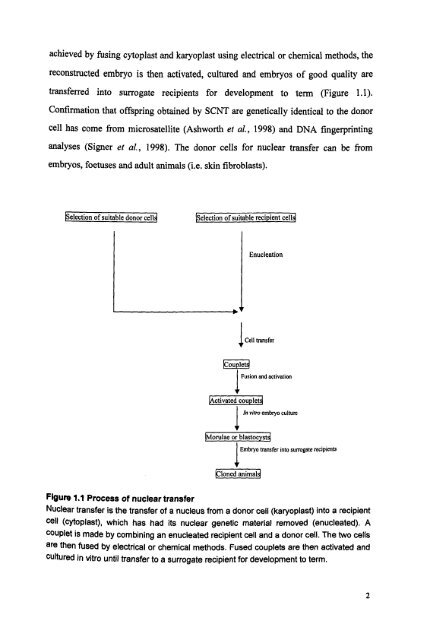- Page 1 and 2: The University of -210 Nottingham M
- Page 3 and 4: treated oocytes was recorded at 38
- Page 5 and 6: TABLE OF CONTENTS ABSTRACT ........
- Page 7 and 8: 2.5.1.2 Preparation of enucleation/
- Page 9 and 10: CHAPTER 6 .........................
- Page 11 and 12: LIST OF FIGURES Figure 1.1 Process
- Page 13 and 14: LIST OF ABBREVIATIONS A23187 AC AI
- Page 15 and 16: MgSO4.7H20 MAPK MAPKK MAPKKK MBP mg
- Page 17: CHAPTER 1 LITERATURE REVIEW The aim
- Page 21 and 22: cytoplasm which contained the nucle
- Page 23 and 24: pluripotency, as demonstrated by th
- Page 25 and 26: gene-targeting via somatic cell clo
- Page 27 and 28: conventional breeding and genetic m
- Page 29 and 30: Oocyte maturation is generally cont
- Page 31 and 32: ooýcýýommý MPF Time Figure 1.3
- Page 33 and 34: not obtain clones by SCNT using bra
- Page 35 and 36: A Nuclear NEBD PCC reformation DNA
- Page 37 and 38: 1.2.3.2 MPF, MAPK, NEBD and PCC in
- Page 39 and 40: Little is known about the mechanism
- Page 41 and 42: development of porcine embryos prod
- Page 43 and 44: short-wavelength, UV excitable fluo
- Page 45 and 46: The procedure is to expel the PBI a
- Page 47 and 48: The majority of successful porcine
- Page 49 and 50: Until 1997, the established dogma i
- Page 51 and 52: deacetylases (HDACs). Trichostatin
- Page 53 and 54: Figure 1.5 presents the general exp
- Page 55 and 56: CHAPTER 2 General materials and met
- Page 57 and 58: 2.3 Oocyte staining and assessment
- Page 59 and 60: holding pipette enucleation pipette
- Page 61 and 62: ! 00-0 !".. ww "'') ^ýýe ;ý ý
- Page 63 and 64: ,rjý. 7!: rY Is All Pi D r. Figure
- Page 65 and 66: were washed three times in embryo c
- Page 67 and 68: Three replicates of batches of oocy
- Page 69 and 70:
fertilisation, the occurrence of po
- Page 71 and 72:
3.2 MATERIALS AND METHODS 3.2.1 Exp
- Page 73 and 74:
I 57
- Page 75 and 76:
3.3 RESULTS 3.3.1 Conventional matu
- Page 77 and 78:
ýIC M 00 N N N N 0 öa oÜd U 0 0
- Page 79 and 80:
Meiotic stage in CAMP treated oocyt
- Page 81 and 82:
3.4 DISCUSSION The development of N
- Page 83 and 84:
44 h. It was comparable to that (93
- Page 85 and 86:
oocyte (Chen et al., 1990). In the
- Page 87 and 88:
CHAPTER 4 Parthenogenetic developme
- Page 89 and 90:
mechanical and chemical procedures.
- Page 91 and 92:
COCs were collected and oocytes wer
- Page 93 and 94:
f. " ý1403: 0.71 14 - 'Ir I A Figu
- Page 95 and 96:
100% 90% 80% 70% d 60% 50% 0 40% 30
- Page 97 and 98:
4.4 DISCUSSION For successful porci
- Page 99 and 100:
In addition to the listed benefits
- Page 101 and 102:
CHAPTER 5 Effect of caffeine treatm
- Page 103 and 104:
in vitro substrates. In pigs, Naito
- Page 105 and 106:
5.2 MATERIALS AND METHODS 5.2.1 Exp
- Page 107 and 108:
5.2.2 In vitro maturation of porcin
- Page 109 and 110:
Blastocysts at day 7 were stained a
- Page 111 and 112:
Figure 5.2 MPF and MAPK activities
- Page 113 and 114:
A 4500000 N 4000000 3500000 Z 30000
- Page 115 and 116:
e ýo; +ý \.. 4.0 ob "i "s NW Ir
- Page 117 and 118:
5.3.4 Effects of caffeine treatment
- Page 119 and 120:
Figure 5.6 Effects of 5 mM caffeine
- Page 121 and 122:
5.4 DISCUSSION In the first experim
- Page 123 and 124:
In the final experiment, developmen
- Page 125 and 126:
CHAPTER 6 General discussion 7.1 Ma
- Page 127 and 128:
cumulus cells could be observed spe
- Page 129 and 130:
parthenogenetic development excludi
- Page 131 and 132:
demonstrated treatment of the TI en
- Page 133 and 134:
REFERENCES Abeydeera, L. R., Wang,
- Page 135 and 136:
Bromhall, J. D. (1975) Nuclear trna
- Page 137 and 138:
Christmann, L., Jung, T. and Moor,
- Page 139 and 140:
and human ovarian oocytes. Nature,
- Page 141 and 142:
Funahashi, H., Cantley, T. C. and D
- Page 143 and 144:
Hartwell, L. H. (1973) Three additi
- Page 145 and 146:
Jelinkovä, L., Kubelka, M., Motlik
- Page 147 and 148:
Kubelka, M., Anger, M., Pavlok, A.,
- Page 149 and 150:
Le Bourhis, D., Beaujean, N., Ruffi
- Page 151 and 152:
Liu, L., Oldenbourg, R., Trimarchi,
- Page 153 and 154:
Minshull, J., Blow, J. J. and Hunt,
- Page 155 and 156:
Oback, B. and Wells, D. N. Cloning
- Page 157 and 158:
A. E., Garst, A. S., Moore, M., Dem
- Page 159 and 160:
Rossomando, A. J., Payne, D. M., We
- Page 161 and 162:
Spemann, H. Embryonic development a
- Page 163 and 164:
Development. 55(2), 121-127. Törne
- Page 165 and 166:
Production of the first cloned came
- Page 167 and 168:
oocytes. Reproduction, 125(5), 645-
- Page 169 and 170:
00 Cl) h 'Cb a) Ü^W wv F NC a b d
- Page 171 and 172:
In In ý. ö O V %) ö ö N _ ö O
- Page 173 and 174:
- u2 y vý'ý OOU 1-1 00 ^ OO NN ö
- Page 175 and 176:
aý yy U a 2 w I-N O N 'T N 1-1 NO
- Page 177:
. 10 CA aý v 2 4 1-1 1-1 o Np cc o
















